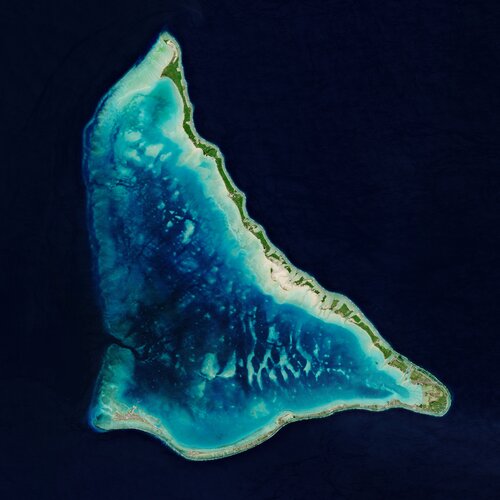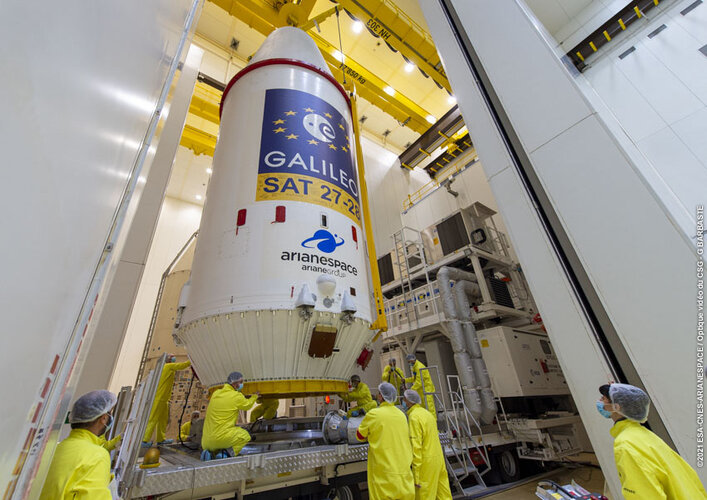
Copernical Team
Sentinel-6 returning most precise data ever on sea level

Sea-level rise is one of the most immediate consequences of climate change, as highlighted recently through urgent pleas from leaders of island nations at the COP26 summit. Global measures of sea-level rise are imperative to underpinning global policy and for strategies to protect coastlines and low-lying lands. Measuring tiny differences in the height of the sea surface from space is no easy task – but that’s exactly what the Copernicus Sentinel-6 Michael Freilich satellite is doing. And, after a year
Galileo: en route to full operational capability
 Video:
00:05:36
Video:
00:05:36
Soon another pair of Galileo satellites will be launched on top of a Soyuz from Europe spaceport in French Guiana. These satellites are the first of the so-called 'Batch 3', comprising of 12 additional first-generation Galileo satellites commissioned in 2017 to bring the constellation to full operational capability. They will be used to further expand the constellation up to 38 satellites and act as backups and spares for satellites that reach their end-of-life.
This 11th Galileo launch also marks the 10 year anniversary of the first launch of the Galileo operational satellites and the start of the construction
Galileo satellites given green light for launch

Europe’s next pair of Galileo satellites have been given a green light for launch. Last Friday’s Launch Readiness Review confirmed that the satellites, the supporting ground installations, and the early operations facilities and teams are ready for lift-off on the early hours of Thursday morning, European time.
Roasted and Shredded by a Stellar Sidekick
 An exhausted star still has some punches to deliver. Astronomers have found that a white dwarf is pummeling a companion object - either a lightweight star or a planet - with incessant blasts of heat and radiation plus a relentless gravitational pull tearing it apart.
Most stars, including the Sun, will become "white dwarfs" after they begin to run out of fuel, expand and cool into a red gi
An exhausted star still has some punches to deliver. Astronomers have found that a white dwarf is pummeling a companion object - either a lightweight star or a planet - with incessant blasts of heat and radiation plus a relentless gravitational pull tearing it apart.
Most stars, including the Sun, will become "white dwarfs" after they begin to run out of fuel, expand and cool into a red gi NASA's X-59 stands on its own
 The NASA and Lockheed Martin team behind the X-59 Quiet SuperSonic Technology (QueSST) have recently removed the aircraft from its jig system, or external supports. The next step is proving the research aircraft is structurally sound and ready for final assembly.
The team has made significant progress on the X-59 QueSST assembly. In late October, they pulled the aircraft away from the jig
The NASA and Lockheed Martin team behind the X-59 Quiet SuperSonic Technology (QueSST) have recently removed the aircraft from its jig system, or external supports. The next step is proving the research aircraft is structurally sound and ready for final assembly.
The team has made significant progress on the X-59 QueSST assembly. In late October, they pulled the aircraft away from the jig Space Force General Admits That US Lagging Behind Russia, China in Hypersonic Weapons
 Last month, the US military botched its own hypersonic missile testing, while China reportedly conducted a test of a missile capable of sending nuclear weapons around the globe this summer. Russia also successfully test-fired its "Zircon" hypersonic missile in the arctic on 18 November.
US Space Force General David Thompson on Saturday warned that American hypersonic missile capabilities a
Last month, the US military botched its own hypersonic missile testing, while China reportedly conducted a test of a missile capable of sending nuclear weapons around the globe this summer. Russia also successfully test-fired its "Zircon" hypersonic missile in the arctic on 18 November.
US Space Force General David Thompson on Saturday warned that American hypersonic missile capabilities a China's Hypersonic test leaves Pentagon officials 'Baffled' by Beijing's advance
 The alleged July test of a hypersonic Chinese missile has sparked concerns in the United States over how Washington seems to lag behind Beijing in the field of hypersonic weapons' capabilities.
The US military and intelligence officials were caught off-guard by China's reported hypersonic missile test carried out in July at five times the speed of sound - an unprecedented feat, The Financi
The alleged July test of a hypersonic Chinese missile has sparked concerns in the United States over how Washington seems to lag behind Beijing in the field of hypersonic weapons' capabilities.
The US military and intelligence officials were caught off-guard by China's reported hypersonic missile test carried out in July at five times the speed of sound - an unprecedented feat, The Financi Nanoracks to deploy first 0.3U CubeSat from Space Station
 Nanoracks Europe is on track to set a new record as the company prepares to deploy the first-ever 0.3U CubeSat from the International Space Station (ISS). The satellite, named FEES2, was developed by the Italian company GP Advanced Projects and is approximately the thickness of a cherry. It will be one of the smallest trackable objects deployed directly from the Space Station.
FEES2 (Flexi
Nanoracks Europe is on track to set a new record as the company prepares to deploy the first-ever 0.3U CubeSat from the International Space Station (ISS). The satellite, named FEES2, was developed by the Italian company GP Advanced Projects and is approximately the thickness of a cherry. It will be one of the smallest trackable objects deployed directly from the Space Station.
FEES2 (Flexi Mining tech heads for the stars as IMDEX backs lunar rover project
 Mining-tech leaders IMDEX - the company behind breakthrough drill and blast technology BLASTDOG TM - is backing development of an Australian-made lunar rover that NASA could send to the moon by 2026.
IMDEX is part of a group of companies supporting Australian Remote Operations for Space and Earth (AROSE) that is looking to leverage autonomous technology prevalent in the mining sector for u
Mining-tech leaders IMDEX - the company behind breakthrough drill and blast technology BLASTDOG TM - is backing development of an Australian-made lunar rover that NASA could send to the moon by 2026.
IMDEX is part of a group of companies supporting Australian Remote Operations for Space and Earth (AROSE) that is looking to leverage autonomous technology prevalent in the mining sector for u Russia's Prichal module docks at ISS
 Russia's new docking module Prichal on Friday successfully docked with the International Space Station (ISS), the Russian space agency Roscosmos said.
The new addition to the ISS completed an automated docking with the nadir (Earth-facing) port of Russia's Nauka lab module at 1519 GMT, it said.
Roscosmos chief Dmitry Rogozin congratulated the Russian crew members of the ISS on the "suc
Russia's new docking module Prichal on Friday successfully docked with the International Space Station (ISS), the Russian space agency Roscosmos said.
The new addition to the ISS completed an automated docking with the nadir (Earth-facing) port of Russia's Nauka lab module at 1519 GMT, it said.
Roscosmos chief Dmitry Rogozin congratulated the Russian crew members of the ISS on the "suc 